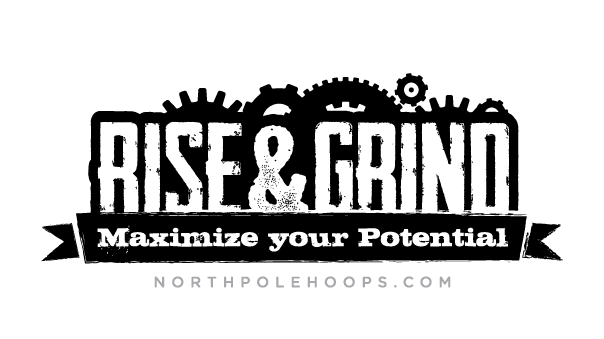
Rise & Grind: Back to the Basics for Your Most Explosive Season Yet!

Basketball is an explosive sport that requires a high level of explosiveness in a variety of movements to excel. Today, more than ever, athletes are at risk to be confused as to which methods will be the most effective for improving their explosiveness on the court.
With high volume training program gimmicks such as Air Alert, and the false hope delivered from plyometric shoes, athletes of all ages are being left injured, weak, and in the end, simply not explosive. Unfortunately, athletes are being led astray from the basic science that truly will GUARANTEE results. As can be found in the book, ’Supertraining’ (1), there are four basic athletic skill-sets that must be addressed in order to be as explosive as possible.
1) The general ability to display explosive strength
2) The maximum strength of the athlete
3) The ability of the muscles to rapidly display starting strength
4) The ability of the muscles to quickly develop acceleration strength
Not to leave you hanging, these skills can be defined as the following:
General Explosive strength refers to the general ability to produce maximal force in minimal time. On a basketball court, this refers to your overall explosiveness in movements such as the defensive slide, first step quickness, and vertical leap.
Maximum strength refers to the athlete’s strength potential. It is a measure of how much total force you are capable of producing. Maximum strength is the precursor to all other athletic attributes including speed, vertical leap and even endurance.
Starting strength refers to the ability to build up working force as rapidly as possible when starting from a static position. On a basketball court, this would refer to any scenario where you must explode forward, backward, laterally, or vertically without a rapid pre-stretch of the muscles.
Acceleration strength describes the ability of the muscle to build up force as rapidly as possible. On the basketball court, this would refer to scenarios where you must build up speed as quickly as possible such as when exploding out on the break, or performing hesitation moves.
One more skill that can possibly be classified as a sub-category to explosive strength, is reactive ability. Reactive ability refers to the ability of the agonist muscle to quickly switch from an eccentric contraction to a concentric contraction using the elastic energy of the stretch reflex to increase the power of the subsequent contraction. Almost all actions on the basketball court require reactive ability to some degree, but in it’s truest sense, reactive ability would refer to movements such as second jump ability when continuously leaping for a rebound or a put back lay-up/dunk.
Now that the definitions are out of the way, you may be wondering what exercises to do in order to develop each of these skills. Below I have listed a few examples of exercises to focus on each athletic quality. There are many other progressions to these exercises that you can do – these are merely meant to give you an idea of what each type of strength would look like.
General Explosive Strength: Squat Jump, Kettlebell Swing, Rebound Jump
For a sport such as basketball, involving lower body explosive movements that require you to primarily move only your own bodyweight, perform with no added weight or a light load. For pure power development, perform no more than 6 repetitions for these exercises. Once you have become proficient in the technique of the squat jump, for example, you may add a load by holding light dumbbells or racking a barbell on your shoulders.
[youtube UJDJEvathSs]
Maximum Strength: Deadlift, Back Squat, Bulgarian Split Squat
Perform these compound exercises with >/= 85% of your one rep maximum. Complete no more than five repetitions per set, and allow for a recovery time of at least three minutes.
[youtube Ak4zeCkXKDM]
Starting Strength: Squat Jump from a Dead Start, Pin Squat
For the pin squat, set the safety pins on the rack to a height that will allow your thighs to begin the movement parallel to the floor. Occasionally, you may raise the pins to begin the movement in a semi-squat position. Complete no more than five repetitions per set, and allow for a recovery time of at least three minutes.
[youtube 5Lo16m6DAG4]
Acceleration Strength: Hill/Incline Treadmill Sprints, Clean Pull, Squat Jump with Load, Dumbbell Snatch
Select a weight that will allow you to exert full force without having to slow the weight down. For pure power, run no further than 20 yards for the hill sprints, and complete no more than five repetitions per set for the weighted exercises, and allow for a recovery time of at least three minutes.
[youtube XFipaUu3dys]
Reactive Ability: Skipping/Pogo Jumps, Ankle Jumps, Depth Jumps
Try different skipping variations to increase overall athleticism. Perform no more than 6 repetitions per set of the tuck jumps.
[youtube rE3v9K8En20]
All of these types of strength complement one another, and it is important to be assessed to determine which of these types of strength you have an abundance of, and which types you need to develop to become a well-rounded explosive athlete.
As a sidenote, if your main goal is to dunk, remember that jumping is a skill. While it is important to train in the gym, it is very hard to replicate the timing required to actually dunk in the gym. Whenever you are on the court, practice backboard slaps, rim touches/grabs, or dunks themselves. Practice jumping off one foot, two feet, from a run, from a standstill, and dynamic jumps. Try to fit in 15-20 deliberate dunk attempts every time you are on the court.
For optimal results and safety, do not perform any of the above exercises to exhaustion.
Remember to ensure that you have had a movement screen before beginning any training program. Most importantly, see a qualified strength & conditioning professional to make sure you can perform these exercises correctly.
Please e-mail me today at Sean@NorthPoleHoops.com if you have any questions on how to integrate these skills and exercises into your program.
Key Points:
-Don’t use training gimmicks such as high volume jump programs or plyometric shoes – these will leave you injured and without results
-Get really strong with compound maximum strength exercises, keeping the number of reps low, and the rest periods high
-Perform explosive exercises with your bodyweight, and also perform them with varying degrees of load.
-Perform some exercises utilizing your stretch shortening cycle, and some exercises from a dead start
-Perform reactive ability exercises where you focus on getting off the ground as fast as possible
-Practice the skill your training for! (Dunking, Defensive Slides, Accelerations etc.)
Sources:
(1) Siff, Mel C. Supertraining. Supertraining Institute. Denver, CO., 2004.

